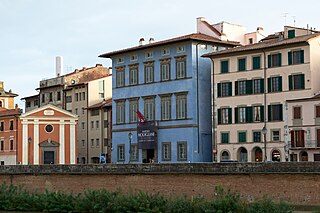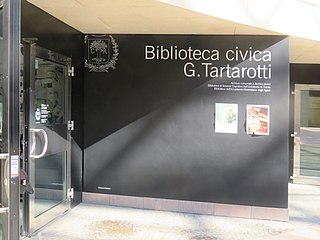
Padua is a city and comune (municipality) in Veneto, northern Italy, and the capital of the province of Padua. The city lies on the banks of the river Bacchiglione, 40 kilometres west of Venice and 29 km southeast of Vicenza, and has a population of 214,000. It is also the economic and communications hub of the area. Padua is sometimes included, with Venice and Treviso, in the Padua-Treviso-Venice Metropolitan Area (PATREVE) which has a population of around 2,600,000.

Vicenza is a city in northeastern Italy. It is in the Veneto region, at the northern base of the Monte Berico, where it straddles the River Bacchiglione. Vicenza is approximately 60 kilometres (37 mi) west of Venice and 200 kilometres (120 mi) east of Milan.

Treviso is a city and comune (municipality) in the Veneto region of northern Italy. It is the capital of the province of Treviso and the municipality has 85,188 inhabitants. Some 3,000 live within the Venetian walls or in the historical and monumental center; some 80,000 live in the urban center while the city hinterland has a population of approximately 170,000.

The Palazzo Vecchio is the town hall of Florence, Italy. It overlooks the Piazza della Signoria, which holds a copy of Michelangelo's David statue, and the gallery of statues in the adjacent Loggia dei Lanzi.

Palazzo Farnese is a palace in Piacenza, northern Italy.

The Palatine Gate is a Roman Age city gate located in Turin, Italy. The gate provided access through the city walls of Julia Augusta Taurinorum from the North side and, as a result, it constituted the Porta Principalis Dextra of the old town.

Padua Cathedral, or Basilica Cathedral of Saint Mary of the Assumption, is a Catholic church and minor basilica located on the east end of Piazza Duomo, adjacent to the bishop's palace in Padua, Veneto, Italy.

The Ghislieri College, founded in 1567 by Pope Pius V, is the second-oldest college in Pavia and co-founder of the IUSS in Pavia as well.

The Doge's Palace is a historical building in Genoa, northern Italy.

The Royal Palace of Milan was the seat of government in the Italian city of Milan for many centuries. Today, it serves as a cultural centre and it is home to international art exhibitions. It spans through an area of 7,000 square meters and it regularly hosts modern and contemporary art works and famous collections in cooperation with notable museums and cultural institutions from across the world. More than 1,500 masterpieces are on display annually.

Palazzo Fava or Palazzo Fava-Ghisilieri is a historic palace at 2 via Manzoni in Bologna, now housing art exhibitions and the Caffè Letterario Carracci Fava. It is most notable for its three rooms of frescoes of scenes from the lives of Jason, Medea, Europa and Aeneas by Ludovico Carracci, Agostino Carracci and Annibale Carracci, commissioned in 1584 by Filippo Fava - he was introduced to them by his tailor Antonio, Agostino and Annibale's father.

The Palazzo Leoni Montanari is a late Baroque palace located in Contra’ San Corona number 25 in central Vicenza in the Veneto region of Italy. It now houses exhibition rooms, meeting places, and art collections owned by the bank, Intesa Sanpaolo.

The Palazzo Giustinian Lolin is a Baroque style palace located on the Grand Canal of Venice, Italy. The present facade was designed circa 1630 by Baldassare Longhena. It is used as an exhibition venue for the Venice Biennale.

Palazzo Blu is a former aristocratic palace, now a center for temporary exhibitions and cultural activities located in 9 Lungarno Gambacorti, in the heart of the historic center of Pisa, region of Tuscany, Italy. This museum is managed by the Fondazione Palazzo Blu, and is located in the Palazzo Giuli Rosselmini Gualandi, ancient palace restored by the Fondazione Pisa. Its name comes from the blue color uncovered during an architectural recent restoration, and attributable to the taste of Russian owners who acquired the Palazzo in the eighteenth century.

The Palazzo Loredan Cini is a Gothic-style palace located between the Palazzo Balbi Valier and the Rio San Vio on the Grand Canal, in the sestiere of Dorsoduro, Venice, Italy. The palace was formed from the amalgamation of the former Palazzo Foscari-Loredan with the adjacent Palazzo Grimani. The narrow facade on the Canal has no entrance, but the facade to the north on the Rio, has a single water door, and is connected to the adjacent campo by a bridge. The facade is decorated with two poliforas.

The Biblioteca Civica Girolamo Tartarotti is the public library of Rovereto located on Corso Angelo Bettini #43, and forms part of the modern (2002) cultural center, including the Museum of Modern and Contemporary Art of Trento and Rovereto or MART, built adjacent to the 18th-century Palazzo Annona in the town of Rovereto, region of Trentino-Alto Adige, Italy.

The Palazzo Moroni is a palace located on Via Porta #12 in the historic center of the upper town of Bergamo, Italy. The palace is a civic art museum, as well as used for cultural functions. The building, noted for its Baroque interior decorations, is presently managed by the Fondazione di Palazzo Moroni in conjunction with the city after a donation by Count Antonio Moroni.

San Nicolò is a Romanesque and Gothic-style, Roman Catholic church in Padua, region of Veneto, Italy. It stands in front of a homonymous piazza, and is adjacent to the Palazzo Meschini and Palazzo Brunelli-Bonetti.

Villa Zito is an 18th-century palace located on Via della Liberta #52 in Palermo, region of Sicily, Italy. The structure is now owned by the Fondazione Sicilia and serves as their museum gallery and exhibition space for their collection of artworks, mainly graphic works and paintings, by mainly Sicilian artists from the 17th to the early 20th century.
The Palazzo da Mosto is a Renaissance-style palace located on Via Giovanni Battista Mari 7 in the northwest of the historic center of the town of Reggio Emilia in Italy.



















